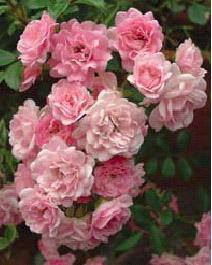| Classification | Polyantha |
|---|---|
| Year Introduced | 1932 |
| Size Category/Growth Habit | Dwarf shrub |
| Height | 3 feet |
| Width | 4 feet |
| Spacing | 6 feet apart on centers |
| Color | Light pink |
| Bloom | Small, double. Successive flushes of bloom spring, summer, and fall. |
| Fragrant | No |
| Planting Site | Full sun, good air circulation |
| Water Use | Keep moist until established (usually requires one month to establish). Average water needs during growing season. |
| Cold Hardiness | Hardy in zones 4-9 |
| History | Introduced in England by the famous rose breeder, J.A. Bentall. Parentage is ‘Paul Crampel’ x ‘Lady Gay’. |
‘The Fairy’ was first introduced in 1932 and has been popular ever since due to its small size, abundant pink blooms and tough nature. It produces a wealth of small, double, light pink blossoms that may turn blush white during intense heat. The Fairy is very useful for small landscapes due to its size with a mature height of 3 feet and a width of 4 feet. It has a low spreading habit that is great for softening harsh angles, or cascading over the edge of a container. It is outstanding in a massed planting to fill a central bed that is surrounded by a walkway in an Earth-Kind® rose garden or as a border spilling over the front edge of a landscape bed.

Landscape Uses
Grow ‘The Fairy’ in full sun and well drained soils on a 4-6 foot spacing. Keep a 3 inch layer of mulch during the first year of establishment and thereafter. The consistent use of an organic mulch will maintain plant health, nutrition and performance. ‘The Fairy’ is able to withstand a wide range of temperatures, so it can be utilized throughout Texas.
‘The Fairy’ could be used in a hedge, mass planting or container. ‘The Fairy’ has a slightly cascading habit that would look fantastic spilling out over the edge of a raised bed or large container.
‘The Fairy’ is a trooper in the landscape world and one that’s proven itself on performance and longevity.


